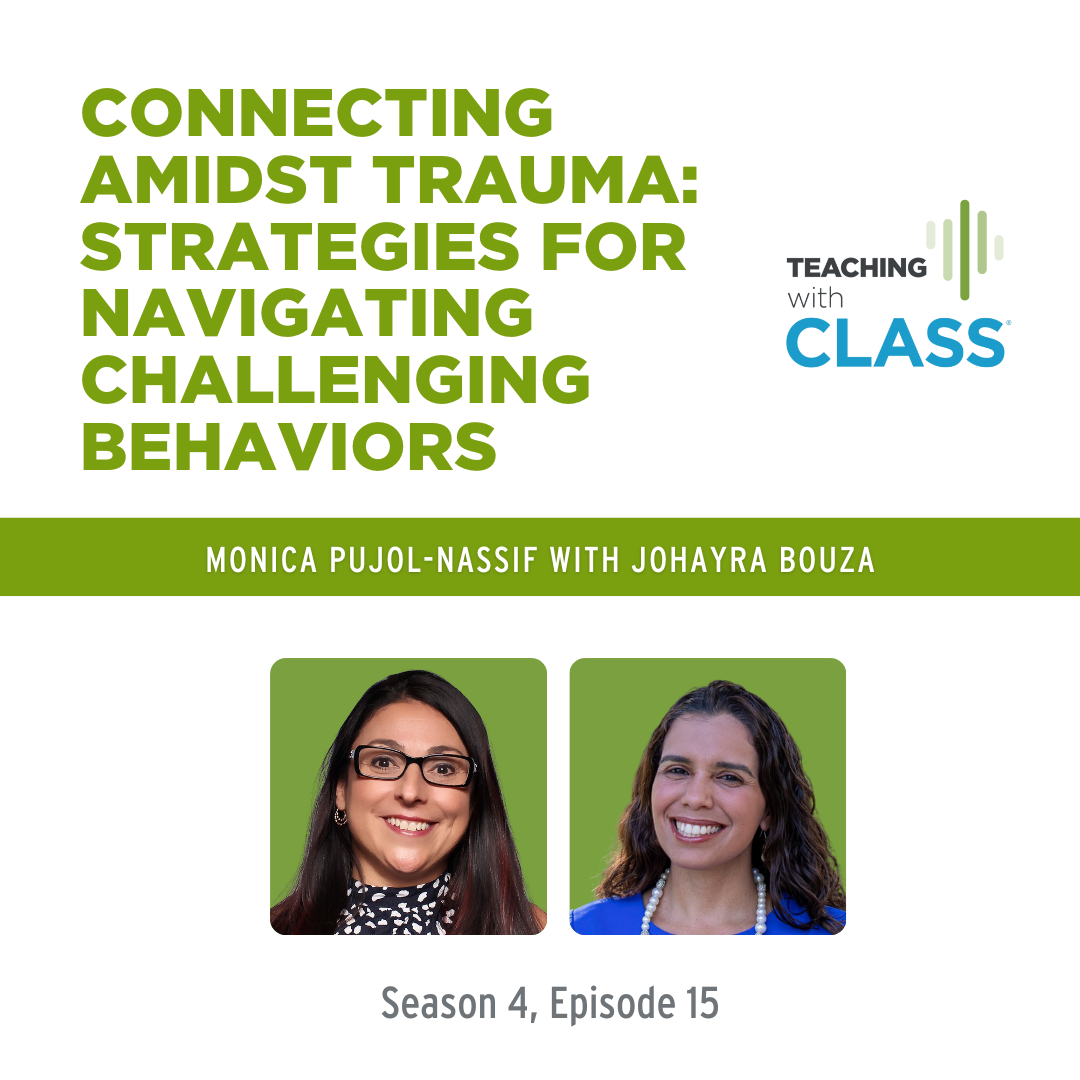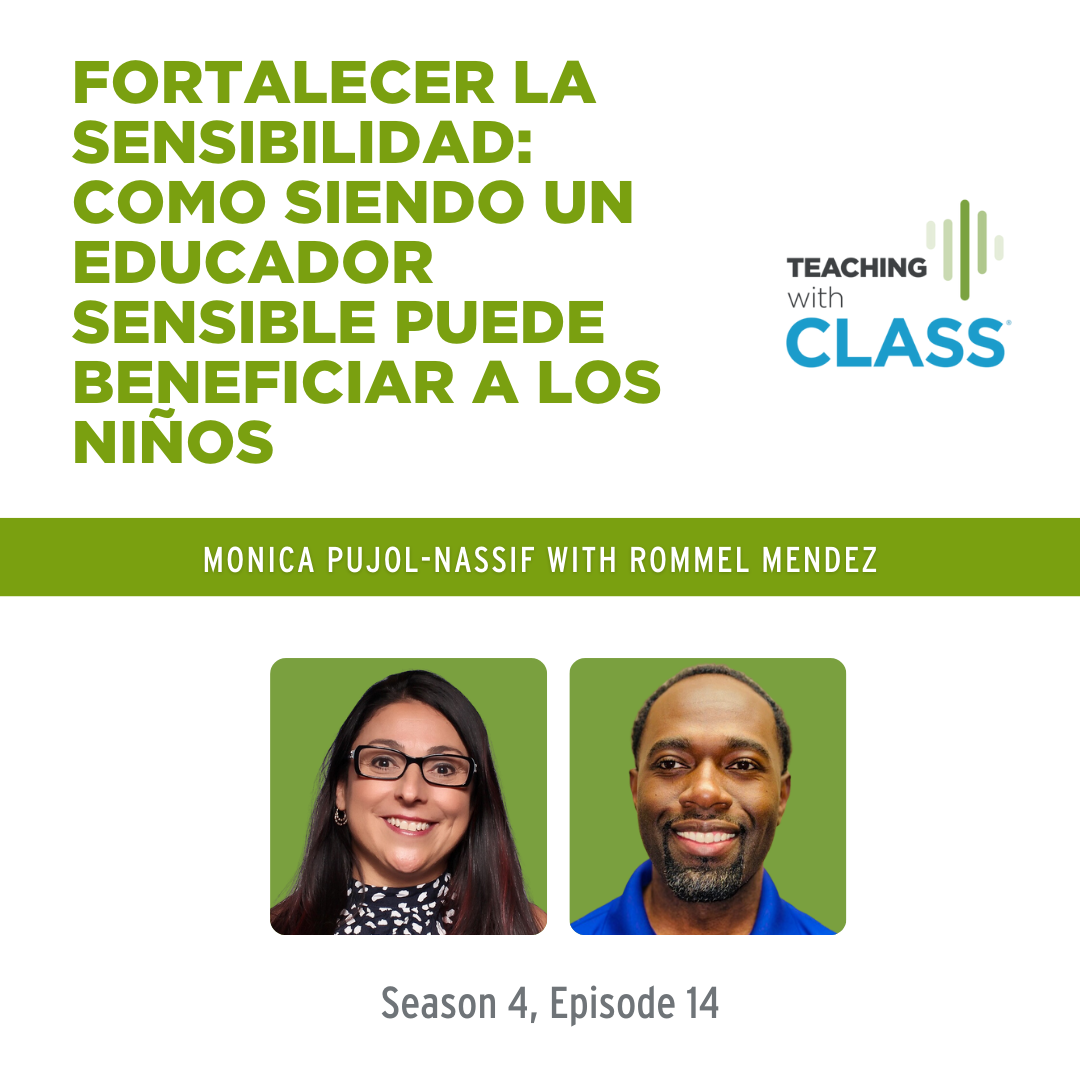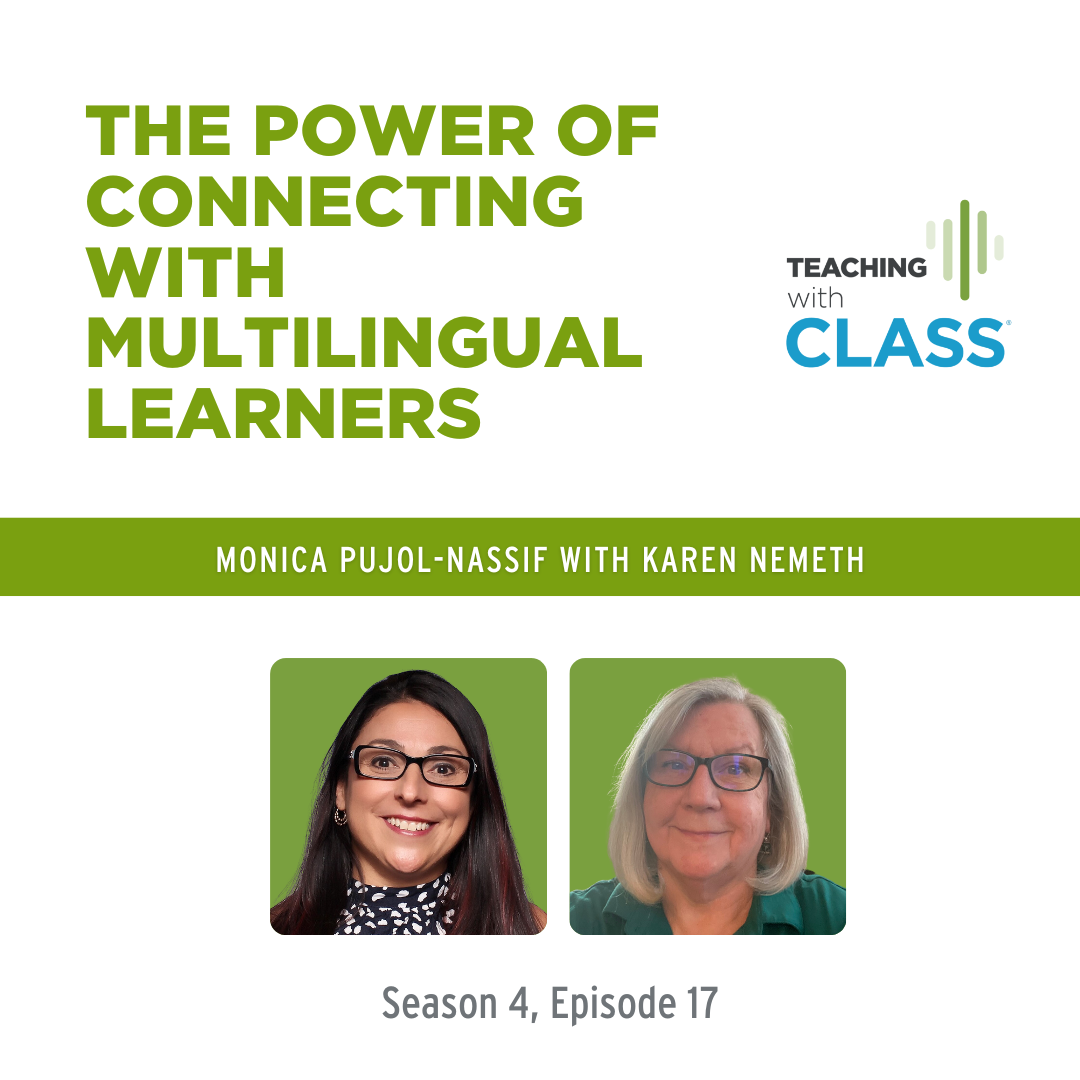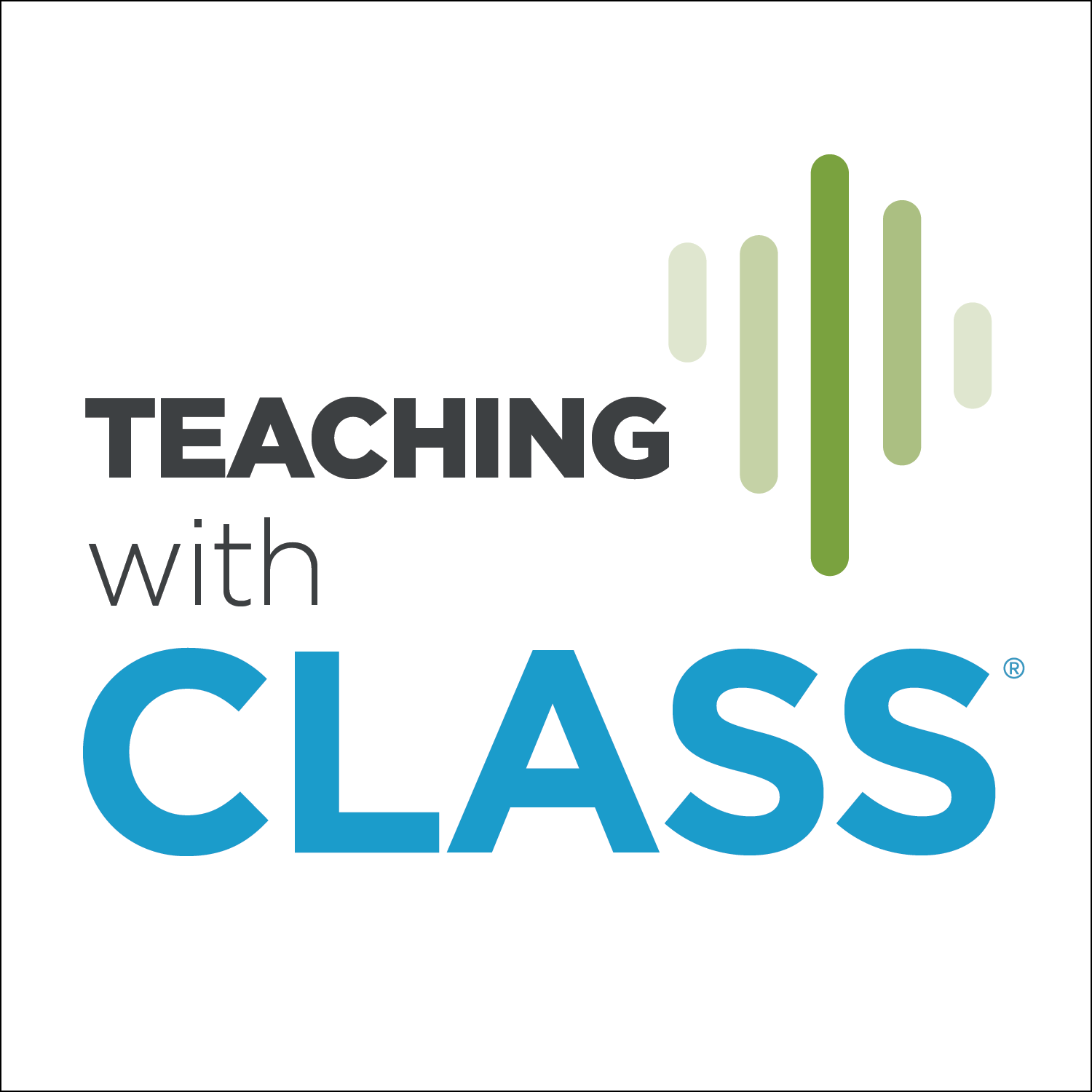Episode Transcript
Monica: Hello and welcome to the Teaching with CLASS podcast, the podcast that gives you quick, actionable tips to easily implement in your classroom. I'm your host, Monica Pujol-Nassif.
In today's episode, we are going to address how to respond to trauma. We are joined today by Dr. Johayra Bouza. Welcome. Thank you so much for being with us and gifting us with your time. Will you tell us a little bit about yourself?
Johayra: Thank you so much, Monica, for inviting me to be on this podcast. It's really an honor to be speaking directly with teachers and knowing that they are going to use this information in their classrooms tomorrow.
My name is Dr. Johayra Bouza, and I work in Miami-Dade County. I've been working with teachers and families here for over 13 years. I started off working in the classroom just supporting the teachers more like an assistant, and working with them to be able to support the development of children. I went on to get my Masters in Statistics and then my Masters in Child Development.
I was one of these children that was born in poverty in a culturally diverse home. It was just so empowering to have teachers that knew how to support my development and knew how to work with my family to support my development. I was so lucky to have teachers just like the ones listening today that were truly invested, that wanted to make my school experience be successful, and give me an opportunity to have the career that I have.
Monica: That is so powerful when you can go back and attribute a lot of your success to teachers. And for the teachers who are listening to see it, you know this. Every day you are making a difference in the life of the children you work with, and in 20 years they're going to say the same thing about you.
Johayra: Yes. Thank you for the 20 years. I appreciate that. My parents were immigrant families from Cuba and they didn't have a lot of knowledge on the system or how to be able to support my development. It was truly because of teachers like the ones listening here today that I was able to get my education, because my parents had no idea how to navigate this system.
That's one of the reasons that I feel very passionate about, that partnership between school and home, because that partnership is what is really needed to be able to bring out the best quality of children.
Monica: Absolutely. Your expertise and your education is going to inform a lot of what we are going to talk about today. But I really love how you're connecting your personal life with teachers, with your experience, with your success, and who you are today.
Johayra: Thank you. I think that being in the classroom with real teachers with real children, really is going to help us understand what are some actionable steps that we can do, which is important, but knowing a little bit of the background.
My whole life was made possible because of teachers, because of my parents working together. I think it really helps us understand where that passion comes from and gives us hope to see, if someone like me can make it because of teachers like this, then the kids in your classroom are going to be able to make it.
Monica: Thank you so much. My dear teachers, we have been listening to your call for help. We're almost at the end of this year with the episodes, but we didn't want to finish the year without addressing this important topic, and we found the best person to help us with this. So we've been hearing you.
Everything has changed, children's behaviors have changed, and you want to understand those behaviors. With that, you have also seen extreme behaviors that you just say, I just don't know how to do this. I've been implementing strategies that I've been learning, working with the CLASS tool and improving every year, but now it just seems like it's more extreme.
As all of you know, and we know, these behaviors are trying to tell us something. So we are going to address that, how to support you, to support your children who are going through any kind of difficult time in their life. They're coming to your classrooms. They're interacting with you and with your other children. It is a sensitive topic, it's so powerful, and again, it's in response to your call for help.
Dr. Johayra, lately we've seen an increase in those challenging behaviors in the classrooms. What maybe some of the reasons for this change, for the change in the challenging behaviors?
Johayra: I know many of us are working with early childhood. If we think of March 2020, our lives change. COVID came into our lives. Many of our children were quarantined with their families at home. Their families were under a lot of financial stress.
Sometimes, unfortunately, there were a lot of family situations like domestic violence, incarceration, and a lot of the children were suffering through that stress. So we are going to see an increase of challenging behavior as a consequence of these situations.
Even the children that didn't have those impactful life-changing situations like domestic violence or incarceration, they were socially isolated. They were interacting maybe mostly with their parents or immediate families. They weren't getting the opportunities to go out to the grocery store, to go to a playground. Every single moment of children's lives, they are learning how to socialize, and we limited that for them.
Now, we're seeing that these children don't have a lot of the skills that we expect them to have at this age. It is because they didn't have a lot of those opportunities in their environment to learn during that time.
There are a lot of possible reasons for that increase in challenging behavior, but a big component of it is these children that live through the COVID epidemic and the quarantine and everything that was happening during that time.
Monica: Absolutely. I am sure as you are talking, all the teachers are saying, exactly, that is what I've been seeing. When we think of that, of this is a different generation of children who were limited in their interactions, what would you say are some of those challenging behaviors children are exhibiting in the classrooms today?
Johayra: We're seeing a lot of the same challenging behavior as before, but a huge increase. Things like fighting, things like hitting. We also see children who want to be completely isolated in the classroom. A lot of more selective mutism, a lot more isolation. We actually see challenging behaviors on both sides of the spectrum, and there's an increase in them.
When you are a teacher and you're walking into a classroom, where the child who refuses to talk to you, or there's a child who's kicking you, or biting other kids, that is really hard. I'm sure that the teachers that are listening today, if they've experienced some of that, they can attest to the amount of frustration that they feel and the amount of their own challenges that they have also experienced post-COVID. They have dealt with things as well. And then that's coming into the classroom where we're interacting with these children that need a lot more of our help.
Monica: I had two points here that are so important. You teachers, you yourselves are going through some challenges because we went through the same kind of trauma. And in the classrooms, you have a spectrum from selective mutism and isolation, all the way to kicking or spitting on you. It's not easy. It's not easy, period, but also because it's adding to your own journey.
So it is frustrating. It could be frustrating to deal with those challenging behaviors. Could you share with us some ways to cope with challenging behaviors in that specific moment?
Johayra: When that moment happens, I want to first validate the feeling of the teacher. Like we always talk about validating the feelings of children. But teachers are human beings as well. I want to say it is totally normal for you to be frustrated. It's totally normal for you to feel an increase in your heart rate.
Sometimes, some teachers have described to me how it feels, like fire is going through their body because they're getting so upset in the moment that this is happening. That is a normal part of dealing with challenging behavior.
That said, we know that if we carry those feelings into the interactions with children that are having that challenging behavior, we are meeting fire with fire. That fire is only going to grow.
The first thing that I always recommend to all teachers is take a deep breath. In that moment, breathe in through your nose, the same thing that we tell children. Smell the flowers and blow out the candle. Activate the nervous system that says you are in a calm environment. Because if you don't, we are going to actually magnify that challenging behavior. So the first thing that we do is take a deep breath and remind yourself that it is important for you to stay calm to be able to overcome this with the child.
The next thing that we have to do is to set a boundary and tell children what they do have to do. So let's suppose the situation when it comes to biting. We could say, we do not bite our friends. We touch them gently. The first thing we have to do is stop the dangerous behavior. I have to make sure to remove that child from stopping to bite that other child.
I do this in a calm demeanor. I do this in a way that is firm, but not rough. I'm not going to pull the child. I'm not going to yank the child. I am just going to stop that dangerous behavior.
Then as we stop that dangerous behavior, we want to connect with the child that was bitten. We want to connect with that child and validate their emotion. Are you okay? How are you feeling? Are you sad? Can I help you feel better?
This goes a lot easier when you have a co-teacher in the classroom because you could divide the responsibility. But if you're alone, I've seen some amazing teachers. I'd like to call them superheroes because honestly that's what they are. They're in the process of holding the child and then talking to the other child saying, are you okay? How are you feeling? Are you sad? How can I make you feel better?
Once that child that was the one bitten and has been attended to, now we have to realize that both of those children were in need. So we have to go and connect with the child that was biting as well, because both of those children are trying to communicate something. One was telling you, hey, I was bit, it hurt. And the other one is telling you, I don't have the skills to be able to engage in this.
In that moment, we can also connect with the other child, the one that was biting and saying, I see you're having a hard time using your words. Sometimes, it's really frustrating and really hard to be able to communicate when we have big feelings.
One of the first things that we need to do is that we need to breathe. As a teacher, we can help connect with that child. We ourselves are still trying to calm down because we're still upset as well. So we are trying to do breathing exercises.
Sometimes that works for the child. Other times, especially if you have children who are not used to engaging, they are having a challenging time connecting with the teacher even in that moment. Sometimes, it's sitting down next to that child and just noticing what it is that the child likes.
If you know a child that really likes a car, then you might want to stand next to them and be playing with the car and say I'm playing with this car to calm me down, because when I see the wheels roll it helps calm me down. Do you want to try it?
Engage that child in doing a calming activity that's going to work for the child. It may be breathing, it might be rolling the wheels of the car, it may be stacking the blocks, it may be holding a doll. That's why it's so important that you know the child to get them to be able to calm down.
When all the emotions are calm, then we are going to ask the child that exhibited the challenging behavior to come with you and interact with the child that was bitten. But we're not going to force them to hug. We are not going to force them to say they're sorry, but we're going to model for them how to do it.
We might say something like, Lucas, I know it was hard today when Danny bit you. I just wanted to tell you that I'm so sorry that happened today. Then you can give Danny an opportunity to say something. Say, do you want to say something to your friend, Lucas? Maybe the child nods and says no.
But I promise you the more often that you do this, because you have modeled the right behavior, the child is going to be more likely to want to apologize. They're going to be more likely to want to engage.
So we take a deep breath, we set a boundary, and we connect with both kids. Then we model the behavior that we want to see, which in this case, it was apologizing. Those four strategies, if we use them consistently, we're going to be able to have children that are going to be able to connect better with each other.
Monica: When you're talking, I am going back to all these situations that I've seen in the classrooms. How hard it is for the teachers. So de-escalating yourselves, my beautiful teachers here first. It's almost like practicing that self-regulation. And it has to be so fast because that is happening in the moment.
But three breaths, that's what it takes. Three, just breathe in and out three times with that game of just breathing. That will bring you to a good place to continue with the other steps.
Johayra: I wanted to highlight where you're saying it's so fast. You don't have time in that moment. You have to attend to the dangerous behavior. Something that's going to take five seconds is going to change how you're going to approach that. It's something the classroom dynamic is running fast and you are implementing a strategy that is also very quick.
Monica: The other thing I so appreciate that you said, once the child who was bitten is calm, and then you were able to interact with the other child, the biter, and that child has also come down, sometimes they need more time than others to calm down. Sometimes, they're just furious and they're kicking. It's a harder situation.
Eventually when that happens and you approach the child who was bitten—thank you for saying—we're not going to force that child who bit to do something. You're going to model it. At the same time, think of that child who was bitten.
You don't want to tell the child, hug your friend, give him a kiss. Maybe that child who was bitten doesn't want that right now. This child was hurt by this peer and he's not ready for the hug yet. So it's really thinking of what we are doing that the little things will make a huge difference in resolving that moment.
Johayra: I always tell teachers, imagine that you had an argument with your significant other, and that person said something very hurtful to you. Imagine two minutes later, there was somebody else who came. There was a mediator and said, you guys have to hug. You don't want to be hugged by that person and that person doesn't want to hug you in the moment.
When we put it in the situation where we as adults were like, no, give me a moment. Like I need to breathe, you need to apologize. Like give me a second. If that's us as adults, imagine little kids.
Like you said, maybe the child that was bitten doesn't want to hug. And maybe the child that bit was still like, well, I bit you because you bit me first. So there are a lot of feelings that are going on there that just forcing that physical contact is actually not making things better. It's actually making things worse.
Monica: Absolutely, thank you. I listen to these strategies, I put myself in your shoes, teachers out there, and how you are processing this information. Placing yourselves in those situations and projecting how we see that you can do that next time that you have a situation like that, that there seem to be more these days.
Now, we spoke about what to do after that challenging behavior. Would you talk a little bit about how you would communicate with families of that child with the challenging behavior?
Johayra: This is a quote that I love. I've seen it in a lot of professional development experiences, and I think the more we say it, the more we believe it. “Behind every challenging behavior is a story that's going to break your heart.” Once you dig deep and see what is going on with the families—what is the scenario this child is living in—you get to know why this child is exhibiting these challenging behaviors.
I have had situations where teachers have told me, mom is never home and she's a single parent. The neighbor's watching over this child has her own children and mom is always working. She has to provide. So this child, you know that they're exhibiting challenging behaviors because of lack of connection.
Even before I communicate with families, I always tell teachers, you have to reframe the way that you think about this child. Reflect on the experience that happened. What triggered that behavior? What did you notice about the way the child came in that morning? Are they just hungry? Is that why they're biting? Because they weren't fed in the morning? Are they biting because they are trying to get a toy from someone and they don't have the language to be able to communicate?
Once you try to figure out what the trigger was, I want you to do a little bit of reframing in your head and say, okay, I have figured out the child doesn't have language skills. The child is not able to do X, Y, and Z. But now I want us to think about, okay, what is it that this child can do? What are the skills they do have? What are the interests that they have?
I want you to start there because that is going to help you as a teacher reframe your vision of that child and start seeing the positive things in them. That's going to make you better prepared to communicate with the family.
Once you yourself have seen the skills that the child has, the context that the child behaves the best in, the things that they're able to exhibit that they have learned, the new words, all the great things that these children are able to do, I want you to think about your relationship with your families as a bank account. The same way we talk about banking time with kids, we need to talk about banking time with parents.
Many of us on the call are parents ourselves. If someone is always telling us the bad things our kids are doing, we tend to not like those people. If you have a bank account that's at zero, we cannot start making withdrawals. We have no money. We have to put in work, so we can get income in that bank account.
So the first thing that we're going to start doing is that every single day during pick up or drop off, we're going to say one positive thing we noticed about the child. Maybe it's something super small. Oh, you know that Danny helped us wipe the table today? He's really becoming part of our community here and really trying to help us.
I noticed that Danny was really interested in talking about puppies. Do you have a new puppy at home or something that's going on? He seems to be so happy about this. So making those positive deposits of when you're talking to the families, for the most part you're talking about these really positive things.
Get to know that family. What are some things that you like to do with your child at home? What are some things that your child likes to eat at home? What is it that your child likes to see? What are the cartoons they like to see?
As you're trying to get to know that family and getting to know that child, you're doing it in a way that's respectful. You're doing it in a way that's valuing them as a family. They're going to start to have a more open line of communication with you.
Then it might come a time where it's time for you to inform the parent of some of this challenging behavior. You might want to say, you know? The other day, Danny bit Lucas. It was really hard for me at the moment, but I've started to implement these strategies. I've started to better connect with the child. I've started to see Danny all the things that they're capable of doing.
I've noticed that now Danny is able to give a toy to their friend. Not all the time, but sometimes they're able to do it. I was just wondering if you've noticed some of this stuff happening at home and what are some of the strategies that you have used, because I want to bring those things into the classroom.
Maybe the parent tells you nothing or I punish them. That's why they don't do it. And there is your opportunity as a teacher, as someone who's collaborating with that parent and saying, I see that the strategy that you're working with at home is working for you. That is okay for it to work at home.
But I am using these strategies in a classroom to better connect with the child. Do you want to try some of these strategies? Is there something that you already do with your child that may be on the ride home and you want to just ask them how their day was? And see how it goes. Then find out with that family next time and say, how's that going? When you ask your child, what did they eat today in the classroom? Was your child able to share with you? How is that going?
That interaction is going to start to build the connection between that parent and that child. As those parents and children become more connected, you're also going to see that there is a reduction of the challenging behavior, because the two most important people in their lives, they're starting to feel emotionally connected to, and we're going to see a decline in those challenging behaviors.
Monica: Now entering in that trauma, like you said, we don't know what's happening in the home. Maybe they share with us, maybe they don't.
Johayra: That’s okay.
Monica: Right, so being trauma-informed, there is a principle. We're going to presume that everyone has gone to trauma. We don't have to know what it is, but we're going to make that presumption. Above all, we are not going to make it worse. That's the principle of being trauma-informed.
We're not saying it's an easy thing, teachers. We're on your side. We have been teachers in the classroom. We know sometimes it gets so difficult. But based on that principle and everything that Dr. Johayra has been saying to us, make that connection before anything happens. Build those connections. Just become friendly with those families.
Again, you don't have to be best friends. But say good morning and think. When somebody says something beautiful that you've done, how do you feel? They're like, oh, somebody noticed, and you feel good about it. And you might want to do it again and build on it.
Same with the families. If you're saying those things about their children, maybe that single mom with many jobs, and the stress this parent lives with every day, she hasn't been able to notice those things. But you're saying them to the parents and they are like, oh my gosh, my child is doing that.
So that day, as Dr. Johayra just said, that you have to share something that happened, they're ready. It's okay. Tell me what happened. Then that important step that, again, that's another challenge as teachers that you live is connecting with the families.
Everything that you said is super helpful. So what are some specific strategies that you would share with the families, to encourage them to connect with their child at home?
Johayra: I would do a very similar parallel process as we talked about with teachers. One, get parents to notice the great things children are doing. Sometimes parents don't realize how amazing their children are. Get the parents to also reframe their thinking about their child.
Sometimes, as parents it's very quick for us to see the skills that children don't have yet, and we don't notice the skills they are showing us. It could be something as beautiful as kindness.
I worked with a little boy who ended up being diagnosed with ADHD. He did exhibit a lot of challenging behavior in the classroom. He did hit, he bit, but when we were in playground time, almost once a week, he would bring a flower to me. That is a moment of kindness. That is what we want to highlight to the parents.
Parents have experience with kids like that all the time. I'm sure that I'm not the first person he brought a flower to. Getting the parent to see that beauty is important, so those specific strategies of getting the parents to see.
What are the kind things that your child does? What are the things your child is able to do? How is it that your child has helped his sibling? Getting the parent to reframe that, so asking those simple questions to get them to see their child in a positive light.
Then we can ask the families what is it that they are already doing? What is an activity you do with your child? Do you drive them to school? Do you walk them to school? Think about ways that we can incorporate connecting with a child during that time and say, okay, you shower them. You walk them to school. During that time, what are some things that you could ask that child that they might want to talk to you about? It's like, oh, my son loves talking about dinosaurs. Okay, so can you ask him a question about dinosaurs?
And getting that parent in the things that they're already doing in their daily routines. What are some simple questions here and there that they can ask the child, or even notice and highlight to the child like, oh, you know, this morning when you brought me that flower, that made me really happy. Thank you so much for doing that, Danny.
Just those little simple moments, building on what they're already doing. Not adding to what the family has to do. Not telling them what to do, but what they're already doing and how we're going to incorporate those wonderful moments of connection within what they're already doing.
Those are some great practice strategies. That's something that you could be doing during drop-off time, during pick-up time, where it takes a couple of sentences that you're communicating with the families, building on their strengths, and allowing them more additional strategies to connect with the child.
Monica: Beautiful. Okay, so let's start closing this episode with two or three strategies that you want the teachers to live with, concrete strategies, actionable tips that they can do with their children if they're with their children this afternoon or Monday.
Johayra: Let's start, like you said, preventing it. Today when your child gets picked up, think about what you are going to communicate to that family. What positive things are you going to say about this child?
If you realize that you're like, oh man, I haven't seen anything positive yet, try to see it before the pick-up or do it on Monday. Observe the child, build on their interest, and figure out other ways to connect with that child.
Start doing it with the families as well. Communicating with those families, those positive things. Those are the things that we can start doing today, and we can continue doing them next week. Then we can incorporate all the other things that we've talked about today.
Monica: Thank you so much. An amazing episode, amazing conversation, and reflection on. Maybe I just need to start focusing on what it is that the child is trying to tell me? How are you going to connect with them, and how are you going to help the families connect with them during these difficult moments?
Thank you so, so much for your stories today, for sharing your expertise. Teachers out there, you can find today's episode and the transcript on our website at teachstone.com/podcasts.
And thank you, architects of the mind, for sharing your love and wisdom with the children of the world, and for being here to add to your box of wonders. I will see you next time. Bye-bye.





